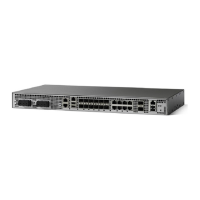Support for IP routing on ATM switches (also called IP and ATM integration)--MPLS enables an ATM
switch to perform virtually all of the functions of an IP router. This capability of an ATM switch stems from
the fact that the MPLS forwarding paradigm, namely, label swapping, is exactly the same as the forwarding
paradigm provided by ATM switch hardware.
The key difference between a conventional ATM switch and an ATM label switch is the control software
used by the latter to establish its virtual channel identifier (VCI) table entries. An ATM label switch uses IP
routing protocols and the Tag Distribution Protocol (TDP) to establish VCI table entries.
An ATM label switch can function as a conventional ATM switch. In this dual mode, the ATM switch resources
(such as VCI space and bandwidth) are partitioned between the MPLS control plane and the ATM control
plane. The MPLS control plane provides IP-based services, while the ATM control plane supports ATM-oriented
functions, such as circuit emulation or PVC services.
How to Configure MPLS
This section explains how to perform the basic configuration required to prepare a router for MPLS switching
and forwarding.
Configuration tasks for other MPLS applications are described in the feature module documentation for the
application.
Configuring a Router for MPLS Switching
MPLS switching on Cisco routers requires that Cisco Express Forwarding be enabled.
For more information about Cisco Express Forwarding commands, see the Cisco IOS Switching Command
Reference.
SUMMARY STEPS
1.
enable
2.
configure terminal
3.
ip cef distributed
DETAILED STEPS
PurposeCommand or Action
Enables privileged EXEC mode.enable
Step 1
Example:
Device> enable
•
Enter your password if prompted.
Enters global configuration mode.configure terminal
Example:
Device# configure terminal
Step 2
MPLS Basic Configuration Guide, Cisco IOS XE Everest 16.5.1 (Cisco ASR 900 Series)
4
Multiprotocol Label Switching (MPLS) on Cisco Routers
How to Configure MPLS

